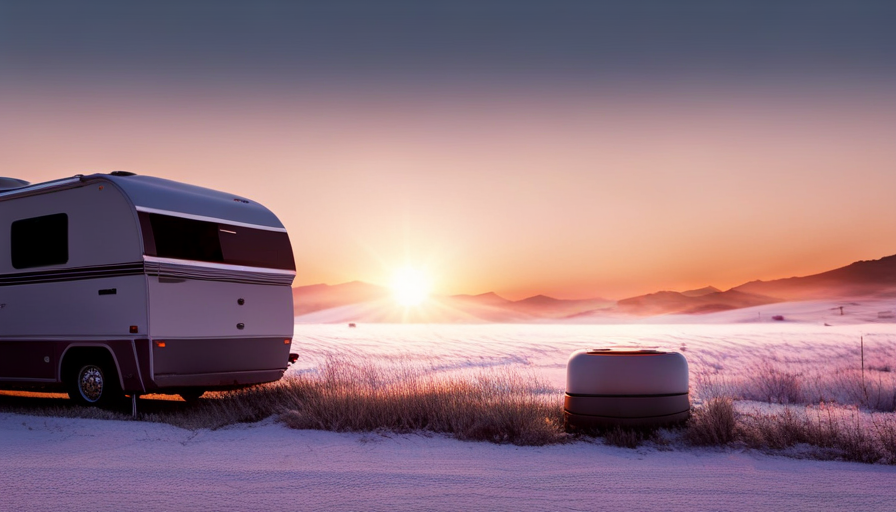When it comes to heating your RV, propane has been the traditional fuel source for many years. However, with rising propane costs and concerns over safety, many RVers are turning to alternative heating methods. Whether you’re a full-time RVer or a weekend warrior, it’s important to know how to keep your home on wheels warm during the cold winter months.
In this article, we’ll provide you with eight tips to heat your RV without propane, including electric heaters, wood and kerosene heaters, additional insulation, skirting, and extra blankets.
The first section of this article will focus on electric heaters. These heaters can be a great option for RVers who have access to electricity and want a safe and efficient way to heat their RV. We’ll cover the different types of electric heaters available, as well as their pros and cons.
The second section will cover other alternative heating methods, such as wood and kerosene heaters, which can be useful for RVers who don’t have access to electricity or want a more traditional heating experience. We’ll also discuss additional tips for keeping your RV warm, such as adding insulation and skirting, and provide advice on how to stay cool during the hot summer months.
Alternative Heating Methods
In the quest for heating an RV without propane, alternative methods have been explored to provide warmth in cold weather conditions.
Electric heaters are a popular choice, as they are effective if electricity is available at the site. Ceramic space heaters come in two types: convection and radiant, and oil heaters are quiet and energy-efficient. Infrared heaters are affordable and quiet, but their heating range is limited, and they give off more light. Safety precautions must be taken when using space heaters, such as keeping them away from flammable materials and not leaving them unattended.
Aside from electric heaters, wood or kerosene heaters can also be used, but they require more attention and maintenance. Diesel or gas heaters provide dry heat and are efficient, while wood stoves can be complicated to install and require storage space for wood.
Additional insulation, skirting, and extra blankets can also help to keep the RV warm. Overall, choosing the right alternative heating method depends on the availability of resources, the size of the RV, and personal preferences.
Electric Heaters
Electric heaters are a viable alternative method for RV heating, particularly if electricity is available at the site. There are several types of electric heaters available on the market, including space heaters, oil-filled heaters, and infrared heaters. Each type has its pros and cons, which are summarized in the table below:
| Type of Electric Heater | Pros | Cons |
|---|---|---|
| Space Heater (Convection) | Effective at heating large areas | Can be noisy and consume a lot of energy |
| Space Heater (Radiant) | Direct and immediate heat | Only heats objects in direct line of sight |
| Oil-Filled Heater | Quiet and energy-efficient | Takes a while to heat up and cool down |
| Infrared Heater | Affordable and quiet | Limited heating range and gives off more light |
It is important to take safety precautions when using electric heaters, such as not placing them near flammable materials and not leaving them unattended. Additionally, electric heaters may not be as effective in extreme cold temperatures, so it is important to supplement with additional insulation and other heating methods as needed.
Other Alternative Methods
Alternative heating methods for RVs include the use of kerosene, gas, or diesel heaters, as well as wood stoves. These methods are especially useful for RVers who often travel to remote areas where propane may be difficult to obtain.
Here are some key points to consider when exploring alternative heating methods for your RV:
- Kerosene heaters: Kerosene heaters are portable and easy to use. They are also relatively inexpensive and can provide heat for several hours. However, kerosene heaters can be dangerous if not used properly, as they emit carbon monoxide and other harmful gases. Therefore, it is important to use them in well-ventilated areas and to follow the manufacturer’s instructions carefully.
- Gas heaters: Gas heaters are also portable and easy to use. They are ideal for RVers who have access to a propane tank or other source of gas. Gas heaters are generally safe, but they must be used in well-ventilated areas to avoid carbon monoxide poisoning.
- Diesel heaters: Diesel heaters are highly efficient and can produce dry heat, making them ideal for RVers who need to dry out wet gear. They are also relatively safe, as they emit fewer harmful gases than kerosene heaters. However, diesel heaters can be expensive and may require professional installation.
- Wood stoves: Wood stoves are a popular option for RVers who want to create a cozy, cabin-like atmosphere. They are also highly efficient and can produce heat for several hours. However, wood stoves can be difficult to install and require space for storing wood. Additionally, they can be dangerous if not used properly, as they emit carbon monoxide and other harmful gases. Therefore, it is important to use them in well-ventilated areas and to follow the manufacturer’s instructions carefully.

